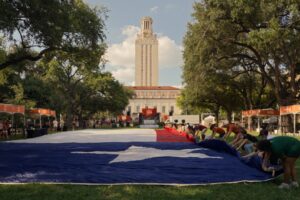Campus myths. Every university has them. Ghosts that haunt the oldest buildings, libraries that are allegedly sinking because the architects didn’t anticipate the weight of the books, undergrads who pass through a certain campus gate won’t graduate.
The University of Texas at Austin is no exception and has its own collection of myths and lore. Below is a just a sampling.
Myth: Bevo was the only mascot
When Theo Bellmont was hired as the university’s first full-time athletic director in 1914, he moved his family from Houston to Austin. The family brought a newly acquired seven-week-old puppy. But instead of keeping the pet at home, Bellmont allowed the dog to freely roam the campus, where he was promptly adopted by the university community. He was soon a regular at athletic contests and was allowed on the sidelines, where his encouraging barks would do the most good.
At a football game the same year, the dog trotted to the sideline and stood next to Gus “Pig” Dittmar. Dittmar played center for the team and was nicknamed “Pig” because he could break through the defensive line “like a greased pig.” Once sharp-eyed students in the stands noticed that both the campus pooch and Dittmar were bowlegged, the dog had found a namesake. Pig Bellmont was the faithful campus mascot for nine years, from 1914 1923.
The first Bevo didn’t arrive until 1916 as an alumni gift to the students, and was presented at the Thanksgiving Day football game against what was then the AandM College of Texas. But a live longhorn steer uncomfortable around people was unapproachable and difficult to manage, and besides, the students already had Pig Bellmont. You could pet a dog, but not a longhorn.
In February 1917, Bevo was branded by a group of Aggies. A week later, the longhorn was hustled off to a ranch west of Austin, after persistent rumors claimed the Aggies planned to return and steal the steer. The United States entered World War I a month later, and for the next two years Bevo was all but forgotten. Costs to feed and care for the animal mounted, and with no plan to house the longhorn on the campus, Bevo eventually returned to Austin as the main course in the January 1920 football banquet. A second Bevo wouldn’t be introduced until 1932, 12 years later.
Myth: Bevo was named because of a branding by AandM pranksters
This is a persistent myth, and is still one of the bestknown stories on the campus. During a late night visit to Austin, a group of Texas Aggie pranksters branded the university’s first longhorn mascot “13 0,” the score of a football game won by Texas AandM. In order to save face, university students altered the brand to read “Bevo” by changing the “13” to a “B,” the “-” to an “E,” and inserting a “V” between the dash and the “0.” For years, the Aggies have proudly touted the stunt as the reason the steer acquired his name.
While the first Bevo was indeed branded 13 0, the rest of the tale isn’t true. Bevo acquired his name months before the Aggies paid their infamous visit, and the brand itself was never changed
Myth: When viewed at an angle, the university’s Tower looks like an owl because it was designed by a Rice University graduate
Of all the campus myths, this is the one I hear most frequently. If you view the top of the tower from a corner, two of the faces of the tower clock are supposed to resemble a pair of owl’s eyes, while the corner of the observation deck suggests a beak.
All of this was allegedly on purpose because the architect of the Main Building and Tower, it’s claimed, was a graduate of Rice University.
Actually, the architect was Paul Cret, who was born in Lyon, France and graduated from the Ecole des Beaux-Arts in Paris.
The origin of this myth might be connected to Dr. William J. Battle, who was hired in 1893 to teach Greek and rose through the ranks to be a professor, dean and, for a short time, the acting university president.
He founded the University Co-op, designed the UT Seal and for many years was the chairman of the Faculty Building Committee, the group that advised the Board of Regents on campus construction.
Battle’s work on the campus was so trusted that no building was approved unless he agreed.
When Battle was first hired, he wound up with the office on the top floor of the Old Main Building. He named his new digs the “owl’s nest.”
In the 1930s, when Old Main was demolished and the new Main Building and Tower were completed, Battle was again given an office on the top floor and continued to call it the owl’s nest. It may be that persons pointing out Battle’s office added the clock faces as owl eyes. After Battle retired in the 1950s, the Tower design might have been mistakenly associated with Rice University.
Myth: The Battle Oaks were saved by Dr. Battle, who sat under the trees with a shotgun and defied the Board of Regents
Not a chance. In fact, using a shotgun at all would be very much out of character for the rather quiet and bookish Dr. Battle.
While Battle was chairman of the Faculty Building Committee in the early 1920s, plans emerged to place a new biological laboratories building at the northwest corner of the campus, which would have meant the destruction of university’s oldest live oaks. Students and faculty raised concerns with Battle, and a group of professors even signed a petition. Battle agreed the trees should be saved, took the matter up with the Board of Regents and convinced them to move the building farther east. The oaks were later named for their champion.
As with the owl face in the Tower, this myth has a likely source. Among those who wrote to Dr. Battle was Judge Robert Batts, a distinguished jurist, UT law professor and later chairman of the Board of Regents (Batts Hall on the South mall is named for him.) When the biological labs building was being designed, Batts had been hired as general counsel for the Gulf Petroleum Company and had temporarily left Austin for Pittsburgh, Pa. Batts’ letter was direct. He told Battle that he would “come down to Austin with a shotgun” if that’s what was needed to save the oaks.
Myth: When seen from above, the Perry-Castaneda Library was designed to appear in the shape of Texas
The Perry-Castaneda Library was opened 30 years ago August 29, 1977 as the main library for the university. If you look at a campus map the right way and use your imagination, it’s possible to think of the outline of the library as similar to the shape of Texas. But this wasn’t intentional. Officially, it’s called a “rhomboid shape” and it complements the similarly designed McCombs School of Business building across the street, which was completed the same year.
Myth: The PCL has a $1 million front door
I overheard this last fall on a tour given to moms and dads during Parents Weekend. “That door cost a million dollars,” declared a rather cynical tour guide to an astonished group of parents. “There’s your tax dollars at work.”
For the record, the door was installed in 1991 with a price tag of $90,000. It was intended to reduce energy costs. The library welcomes more than one million visitors a year. With so much foot traffic, the building’s original automatic sliding doors were letting out too much cooled (or heated) air. The doors have paid for themselves through lower electric bills several times over.
Myth: Burdine Hall looks like a punch-out computer card because it was intended to house the Department of Computer Sciences
Certainly, the window pattern on Burdine is unusual, and this kind of thing is ripe for a campus myth. But it’s not true. Burdine Hall was opened in May 1970 for the departments of Government and Sociology. It’s named for John Alton Burdine, a longtime government professor who also served as dean of the College of Arts and Sciences (which has since separated into several colleges and schools).



